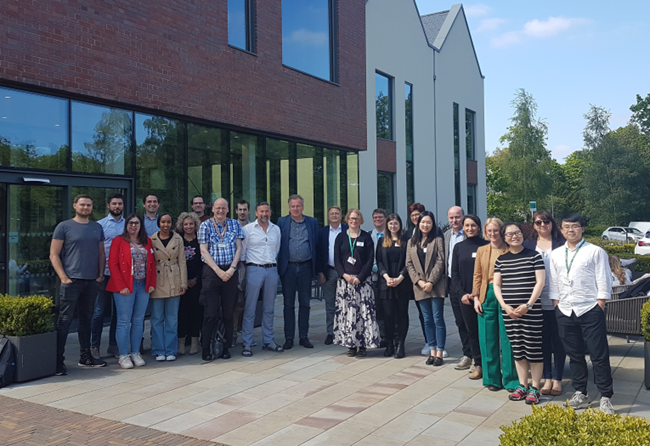5 June 2023 in Birmingham, United Kingdom
On Monday the 5th of June 2023, the Second SIMBA Advisory Board Workshop was held at the University of Birmingham, United Kingdom. Hosted by the University of Birmingham and moderated by Uniresearch, the Second Advisory Board Workshop was a great success by uniting SIMBA partners and Advisory Board (AB) members. The participants engaged in insightful discussions concerning challenges and progress on the SIMBA cell prototype’s characteristics and the steps taken for reclaim and reuse of the SIMBA materials.
The SIMBA AB consists of battery producers including Leclanche, VARTA and GAZ. EnBW as battery end user and ENEA as policy regulator complete the strong competences of the board. The role of the AB is to be involved in the project through three workshops facilitating the exchange of knowledge and of expectation regarding Sodium-Ion batteries (SIBs) while strengthening the SIMBA results. As such, the AB Workshops provide a good opportunity for the SIMBA partners to present their work to potential battery producers, end users and policy makers.
During the morning session of this 2nd SIMBA AB workshop, seven SIMBA partners presented their work progress encompassing the whole SIMBA value chain from material level (cathode, anode, electrolyte) to prototype cell characteristics, recycling and reuse and finally sustainability and life cycle assessment.
In the afternoon, three working groups consisting of a mix of AB members and SIMBA partners were formed to discuss the outcomes of the morning sessions via three leading questions: 1) How do you compare the current state of the SIMBA cell development with SoA of Na-ion batteries? 2) How can the SIMBA-cell contribute to the growth of the Na-ion market versus the Li-ion market? 3) What do the end user and policy maker request from Na-ion technology batteries? (i.e., to align with Pathways to Impact and Exploitation)
The outcomes from the working group discussions have yielded new and ample recommendations for both the SIMBA partners and the project, delineating a promising course for the future of Na-ion batteries. They can be summarized as follows:
- For the end users / battery industry the cost and safety of cell are the most important requirements for adopting a new battery chemistry. Within the SIMBA project, the main safety gains can be achieved through the implementation of much safer solid polymer electrolytes versus traditional liquid electrolyte. Notwithstanding, for some of the end users the SIMBA cell is still in a research phase and SIBs still need to prove their superior safety compared to LIBs.
- On the cost aspect, the cheaper materials used in SIMBA offer big advantages when compared to LIB materials. However, the cost-effectiveness of the hard carbon anode all depends both on the production costs and the availability of the precursor. In addition, regarding the Battery Management System (BMS) costs, SIMBA can contribute to cheaper BMS chips. For example, if SIBs are safe enough they may not require single cell-level BMS control, but instead only at the module level.
- The main SIMBA contribution to the current Na-ion field pinpoints towards the further development of the solid polymer electrolyte. The attendees agreed that the most promising niche market for the SIMBA outcomes concerns the polymer electrolyte. The polymer electrolyte is the most innovative of all the SIMBA materials, but at the same time also the one at an early stage of research with challenges still being addressed.
- On the design for disassembly, the SIMBA results reveal promising advancements in a cost-efficient recycling process, supporting the manufacturing of greener batteries. This approach makes the supply chain healthier, reducing its dependence on mining critical materials from outside Europe and facilitating the local access to these materials.
- Regarding battery regulations, SIBs biggest advantage can be the promise to store and transport it at zero volt. This feature makes the transportation much safer, potentially leading to different regulations for SIBs, for example having these classified as non-dangerous goods. This could be a strong impact on the future of SIBs.
